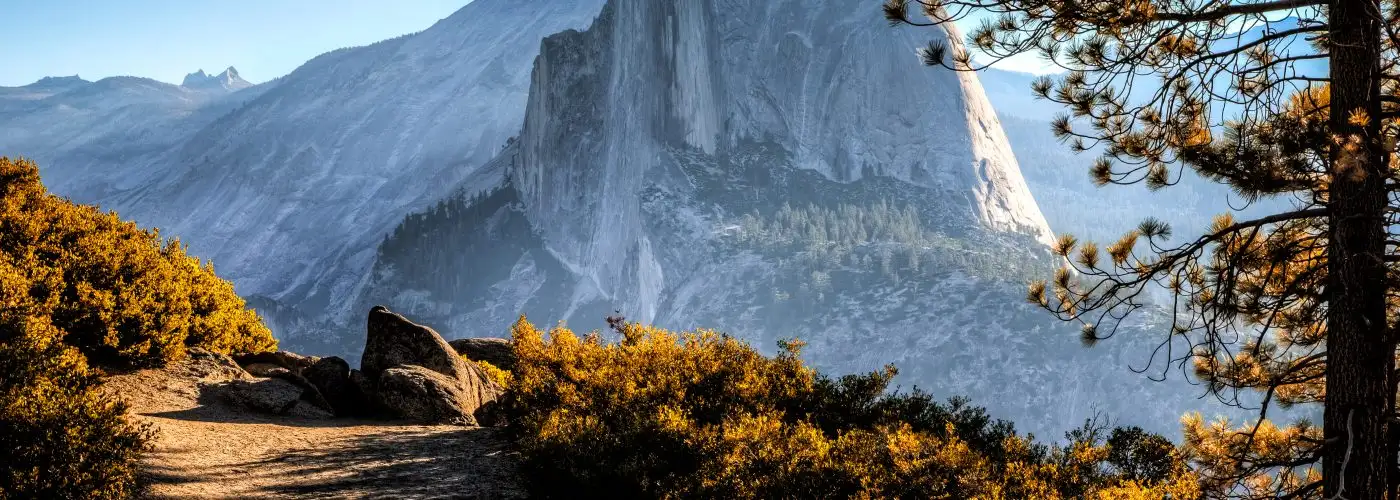Yosemite National Park, perhaps more than any other, is responsible for the broader vision of wilderness conservation in this country, thanks to a Scottish immigrant named John Muir who fell in love with this land, fought to protect its natural wonders and, in the process, founded the Sierra Club.
Famous for its spectacular, towering granite formations—think iconic Half Dome and El Capitan, arguably the most famous climbing face in the world—Yosemite is the nation’s fourth most-popular park, with more than 4 million visitors last year, most of them converging on the 1 by 7.5-mile Yosemite Valley. From the valley, nature-lovers can gaze on or hike to famous falls including Yosemite Falls (the highest in North America at 2,245 feet), Bridalveil, and Nevada Falls. But surrounding Yosemite Valley is nearly 1,200 square miles of high meadows, crystalline lakes, ancient giant sequoias, and evergreen forests—a vast Sierra wilderness that remains relatively untouched.
Why October Is the Perfect Time to Go
Two words: fewer people. From May through September, the valley floor takes on an almost festival-like atmosphere as hundreds of thousands of visitors crowd into the park. But come October, traffic gridlock on the valley floor eases considerably, and hikers on even the most popular trails—like the Mist Trail and the Muir Trail—no longer resemble lines of marching ants.
While the higher elevations are evergreen habitat, Wawona Meadows and Yosemite Valley have started turning fall colors. Daytime temperatures are comfortably warm in the valley (high 60s to low 70s), but higher elevations and nights can be chilly, so be sure to bring layers. This isn’t the time of year for waterfall viewing (most have dried to a trickle by now), but that’s a small price for the peacefulness you’ll enjoy.
Why It’s Great at Other Times of Year
Winter in Yosemite can be nothing short of magical. While Tioga Road and the road to Glacier Point are closed by November (which makes most of the back country inaccessible), Yosemite Valley and Wawona are open year-round. Sip hot chocolate in the warming hut after ice skating at Half Dome Village; enjoy downhill skiing, snowboarding, and snow tubing at Yosemite Ski & Snowboard Area; or cross-country ski on the trails at Crane Flat. Park rangers also guide snowshoe tours from mid-December through March. Of course, once the snow melts, the waterfalls will be in full glory as spring comes to the park—with tourists not far behind.
If You Go, Don’t Miss
John F. Kennedy, Judy Garland, William Shatner, Steve Jobs, Lucile Ball—these are just a few notables who’ve bunked down at the historic Ahwahnee Hotel in Yosemite Valley. Due to a legal dispute with its former concessionaire—which managed to trademark the name of the 89-year-old hotel while no one was looking—the hotel has been renamed (for the time being) the Majestic Yosemite Hotel. It’s more than just a shining example of what has become known as Parkitecture: Its grand public spaces and dining room were Stanley Kubrick’s inspiration for the hotel’s interior in “The Shining.” You don’t have to book a (pricey) room to enjoy the hotel. The magnificent Great Lounge, flanked on either end by enormous cut-sandstone fireplaces, is open to the public for sitting and relaxing. Dinner at the Grand Dining Room, with its views of Yosemite Falls, is a bucket-list must—but for a lower price tag, try the newly renovated bar with its tasty small plates and nice cocktail menu.
October Bonus Pick: Mammoth Caves National Park
Central Kentucky’s hardwood forests are bedecked in full fall foliage by October, covering the rolling hills of Mammoth Caves National Park in vivid hues of gold, orange, purple, and red. Days are typically mild and warm (low to mid-70s)—perfect for hiking the park’s 85 miles of trails or lazily paddling down the Green River.
But beneath the autumnal carpet of color lies a completely different world: the park’s titular cave system, the longest in the world and a UNESCO World Heritage site. A “grand, gloomy, and peculiar place” is how Stephen Bishop, a black slave guide who explored and mapped the area for almost two decades, described Mammoth Caves more than 150 years ago. More than 400 miles of passageways have been mapped to date, with “no end in sight,” as explorers continue to discover more. Park guides lead a number of cave tours, ranging from easy one-hour strolls to an “extremely strenuous” six-hour exploration that requires climbing, hiking, and crawling through the passages.
More from SmarterTravel:
- Grand Canyon National Park: Our September National Park of the Month
- Glacier National Park: Our August National Park of the Month
- Wrangell-St. Elias: Our July National Park of the Month
- Yellowstone National Park: Our June National Park of the Month
- Olympic National Park: Our May National Park of the Month
- Great Smoky Mountains: Our April National Park of the Month
- Hot Springs: Our March National Park of the Month
- Death Valley: Our February National Park of the Month
- Everglades: Our January National Park of the Month
Deb Hopewell is a longtime journalist and the former editor of Yahoo Travel. She writes for Outside, Fodor’s, Architectural Digest, Travel+Leisure, and others. Follow her on Instagram @debhopewell and Twitter @dhopewell.
We hand-pick everything we recommend and select items through testing and reviews. Some products are sent to us free of charge with no incentive to offer a favorable review. We offer our unbiased opinions and do not accept compensation to review products. All items are in stock and prices are accurate at the time of publication. If you buy something through our links, we may earn a commission.
Related
Top Fares From
Today's Top Travel Deals
Brought to you by ShermansTravel
Australia: Upscale, 8-Night Cairns, the Gold...
Down Under Answers
 vacation
$3899+
vacation
$3899+
Greenland: Luxe, All-Incl. 11-Nt Exploration Small-Ship...
Swan Hellenic
 cruise
$3289+
cruise
$3289+
Ohio: Daily Car Rentals from Cincinnati
85OFF.com
 Car Rental
$19+
Car Rental
$19+




